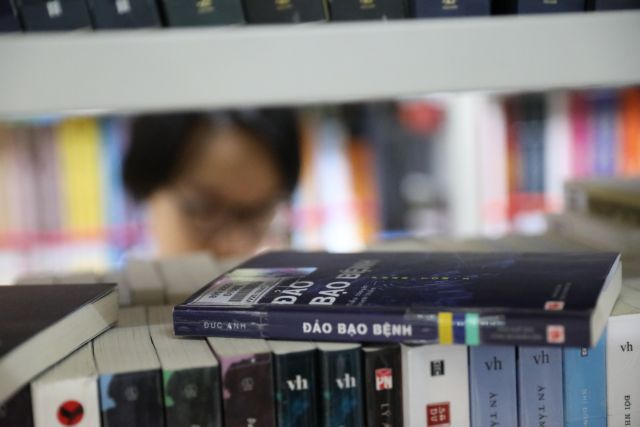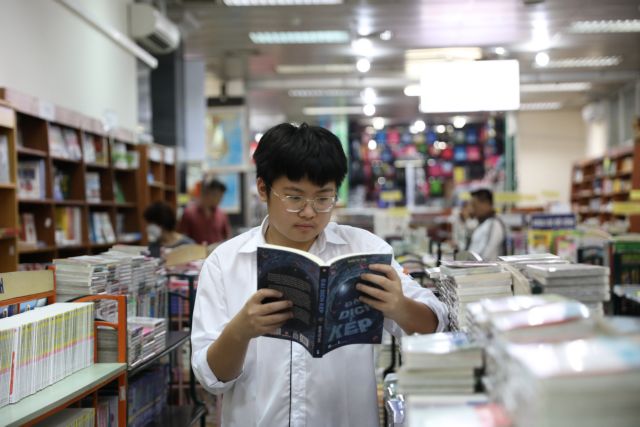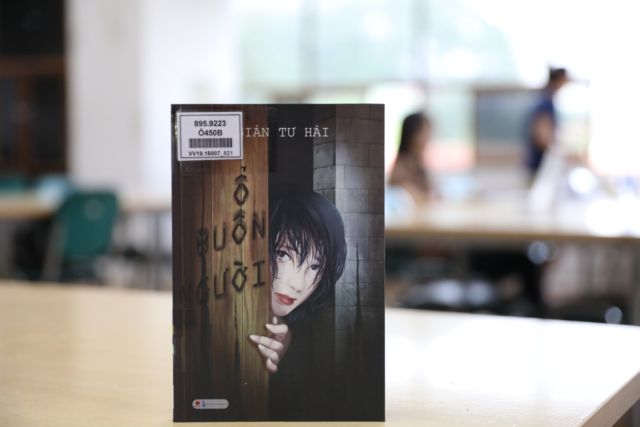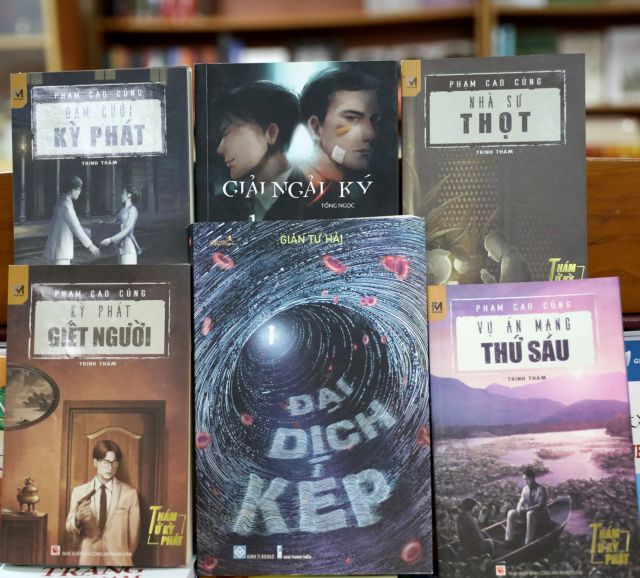
LOOKING FOR CLUES: Trại Hoa Đỏ has been made into an 8-part series by K+, a paid TV channel, directed by Victor Vũ. Photo courtesy of the company
by Nguyễn Mỹ Hà
Ask a Vietnamese man or woman, who is Việt Nam's most famous literary detective, and it will be hard to get an immediate answer. A detective's work always needs a serious crime. Many unsolved crimes in history remain mythical, making the crime more mysterious. Readers have always seemed happy with this.
But the scene has gradually been changing as young writers have added new books to the otherwise rather limited genre in the Vietnamese language. At a recent conference on local detective works, Nguyễn Quang Thiều, chairman of the Việt Nam Writers Association, announced that he believed a literary prize for detective novels would encourage writers to pen new works.
Writers in this style include Kim Tam Long with the 'white' series: Mặt nạ trắng (The White Mask, 2018), Ẩn ức trắng (The White Disturbance, 2020) and Thảm kịch trắng (White Tragedy, 2022). The White Mask sold out and has been reprinted with a new eye-catching cover. The writer usually married life in modern Vietnamese families with a suspended tense atmosphere and a touch of horror.

HERALDED: Đức Anh's Island of Severe Illness won a literary prize. VNS Photo Đoàn Tùng
Đức Anh won a prize with his novel Đảo bạo bệnh (Island of Severe Illness). A well-read writer, Đức Anh has written many sharp essays on detective subjects. He has analysed psychological developments and touched upon novel subjects and innovative ideas. His works, including Tường lửa (Firewall) and Thiên thần mù sương (Foggy Angel), plumb the depths of psychological analysis.

PRIZE WINNER: Writer Đức Anh. VNS Photo Đoàn Tùng
The most recent work by Giản Tư Hải, an architect by training, titled Double Pandemic, took on COVID-19 crimes. Well-read and well-travelled, Hải also won a prize for Ổ buôn người (Human Trafficking Station). He has said the detective genre is his mysterious and appealing passion. His other works included Âm mưu that não (Brain Altering Conspiracy), Mật mã Champa (The Champa Code) and Minh Mạng mật chỉ (The Emperor Secret Decree).

A young reader ponders the pages of Double Pandemic by Giản Tư Hải. VNS Photo Đoàn Tùng
Nguyễn Dương Quỳnh takes on the detective genre with a well-developed plot, with tight and well-knitted layers and interesting details. Her first novel, Thăm thẳm mùa hè (Into the Depth of Summer) appealed to those who like slow-paced rhythm and graceful prose.

SUNNY DISPOSITION: Writer Nguyễn Dương Quỳnh. Photo courtesy of the hanoimoi.com
Detective writer Di Li (a pen name) has a more aggressive style. Her book Trại hoa đỏ (The Red Flower Camp) has been made into a movie by director Victor Vũ. Di Li's other works, including Câu lạc bộ số 7 (The Club No 7), also won literary prizes. Di Li has been credited as the frontrunner in combining detective and horror writing styles.
Despite having a handful of young writers in the first quarter of the 21st century, detective fans say that the new writers have not been able to surpass the first writer in this genre who had his first novel published as a series printed in a newspaper.
The roar of the Tiger
These detective columns appeared in the Catholic Newspaper in 1917, titled A Secret Agent's Tales. They ran as excerpts of a translated novel by Biến Ngũ Nhy, a doctor turned detective writer.
The column ran for three years and influenced a boom of detective writers from 1930-1945. Many writers joined the detective genre, which deeply influenced the Chinese royal crime-solving court and detective action novels. Most popular was detective Arsene Lupin, a flamboyant Robin Hood-style hero who takes from the rich and gives to the poor.

MODERN CLASSIC: Giản Tư Hải's title The Human Trafficking Station. Photo courtesy of Di Li
Sài Gòn's literary circle was vibrant, with literary works and domestic new fiction flourishing. A few years later, a new author, Thế Lữ, published his first detective works titled: Một đêm trăng (A Full Moon Night) and Vàng và máu (Gold and Blood), published by Tân Dân Publishers in 1934.
He studied Chinese Han script, then Vietnamese, and like many people of his time, studied French at public school and even passed the exam to study fine arts at the Ecole des Beaux-Arts de L'Indochine. But he quit after one year, changed his interest to writing poetry and detective novels, and became one of the cornerstones of Vietnamese theatre.
The novels of Thế Lữ became an instant phenomenon, both appealing and arresting, with interesting descriptions that touched hearts due to their amazing details, clear voice and natural wording.
Thế Lữ also created his own detective named Lê Phong in a series of books, including Lê Phong phóng viên (Lê Phong the Reporter, 1937), which sold widely.
The writer incorporated love and jealousy, a clear plot, and specific themes and intricate plots into his work.
Thế Lữ went on with these detective novels until 1940. After that, the revolution movement of the people steered his work in other directions.
During the revolutionary years from 1954 until Việt Nam was unified in 1975, the detective genre hibernated until it had a small revival in the 1980s.
Three-penny novels
In the early 20th century, when the ruling French strengthened their political power with various cultural approaches, the translation of French literature into Vietnamese left a remarkable imprint. Among great works of French poetry and literature, detective novels also captured young readers' hearts, marking a brand new style that was not previously known.

BEST SELLERS: Detective novels of writer Phạm Cao Củng still sell well after nearly a century. VNS Photo Đoàn Tùng
Phạm Cao Củng (1913-2013) wrote 20 detective novels, which were printed in Tiểu thuyết thứ bảy (The Saturday Novel). He is considered the "King of Vietnamese detective stories". Vết tay trên trần (Hand Print on the Ceiling), Gia tài họ Đặng (The Đặng Family's Fortune), Máu đỏ lòng son (Red Blood Scarlet Heart) were his first trio of novels, published in 1937.
Củng's works can be categorised into two streams: analytical detective and adventurous detective. He created Detective Kỳ Phát, the Vietnamese answer to Sherlock Holmes; and Tám Huỳnh Kỳ, head of a looter gang, inspired by French writer Maurice Leblanc, who created Arsene Lupin.
Trained with a traditional education by his father, a scholar in teaching, he learned the Chinese Han script but wrote in romanised Vietnamese and created an imaginative crime series, which was anxiously waited for by the common people.
His works were credited as "three-penny novels", which were dirt cheap and unimportant but very popular. But he didn't mind being a writer for the most ordinary readers, as they looked forward to reading his next chapter while reading his latest.
Writing came to him naturally. As a high school student, he was asked to take care of his aunt's shop at midday in the summer when it was quiet. Having to keep an eye on the shop he started writing to keep himself from falling asleep.
In his adult life, he had to write to make ends meet for his family of 11 children. He would do any jobs: writing for a newspaper, working as a photographer, cameraman, theatre managing director, artist, hypnotiser and fortune-teller, on top of regularly publishing the so-called three-penny novels that were 16 pages long.
He wrapped his life up in a few lines: "In the end, honestly speaking, I was simply just a wordsmith, no more, no less. I wrote for the life of myself and my family as I ploughed to make ends meet. I haven't contributed anything to the national culture like my fellow writers then and now!"
He was truly a writer for the common people.
Revival of the literary detective
According to Chairman Thiều, average Vietnamese readers love to read detective stories. But the number of titles is limited. Writing detective novels can be more challenging than other genres as it requires imagination, a good command of other fields, and specific techniques.
Detectives are closely associated with crime and the crime-solving process. Modern-day detective writing also can convey a humanitarian message. Though detectives are fiction, they must follow real-life rules and realities.
From 1954 until the reforms in the 1980s, during the hibernation period, there were a few notable works such as X30 phá lưới (X30 Scores Goals) by Đặng Thanh, Ván bài lật ngửa, (Open up Game of Cards) by Nguyễn Trương Thiên Lý, and Ông cố vấn (The Advisor) by Hữu Mai. They were successful but solitary singular attempts and didn't create a new flow in the genre.
After reforms vastly changed society, the literary world experienced an important revival of popular novels. Author Đặng Thanh set many impressive publishing records, with Đọ sức (Competing) publishing more than 30,000 copies, a record to this day in Việt Nam.
In the rich literary tradition of Việt Nam, the detective genre is a relative newcomer, closely associated with the westernisation of Vietnamese society in the early 20th century, which came with rational argument, evidence gathering, and developments in science and technology. Detective writers need to understand people and crimes as if they are experts in the field.
After the revival in the 1980s, the comeback of detective novels in the first quarter of this century gives us hope for a much stronger, more diverse literary genre in the future. VNS
OVietnam